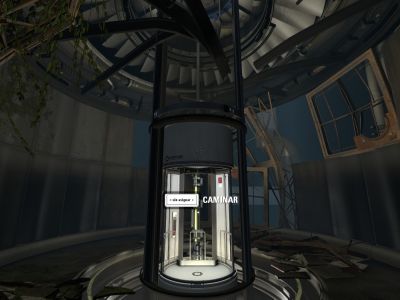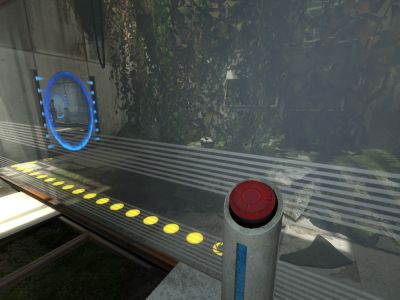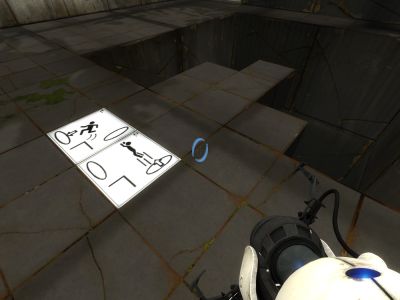
Featured Blog | This community-written post highlights the best of what the game industry has to offer. Read more like it on the Game Developer Blogs or learn how to Submit Your Own Blog Post
Portal 2 game design review: Part 2
Second part of the Portal 2 Game Design review. These series will dissect the constituent (and sometimes unnoticed) game design elements behind acclaimed Valve's Portal 2.

This game review contains spoilers. Please feel free to come back after having completed the Single Player mode of Portal 2. You'll also better understand all what's commented here after having played the game thoroughly.
Chapters 1-3 (continuation)
In Part 1 i omitted several things that’s worth examining. First let me introduce you to your “psychological” friend device… the elevator.
- The elevator
The elevator is introduced at the very beginning of the game, just after the player uses the first box and first switch to open the first door. After taking the elevator, there’s always a loading screen that will take you to a next level or chapter.
My view is that without this mental break that implies taking the elevator, the game couldn’t have been really as funny and memorable. Why?
The complexity of the puzzles makes it necessary to take a rest every certain time to avoid mental saturation (i’m aware that hardcore players may differ on this point). The room where the elevator is, with its big screens and iconic advertisements and voice off from the announcer or GladOS, are an effective way to refresh and reinvigorate the player’s mind, and to unnoticingly make him forget about the test room or situations he has just completed in the last 10-20 minutes to prepare him for the next challenge, creating in him a sense of anticipation for what will come next.

elevator
The “elevator moment” also acts as a reward to the player. It’s like the classic Checkpoint. Once you get to the elevator you’ll come soon to know that you’ve progressed a chunk in the game and there’s no turning back from this point. This exerts a momentary sense of relieve and accomplishment.
It’s important to notice that once in the elevator room, you are not thrown immediately towards the next puzzle, actually, you can stay in the elevator room as long as you wish, it’s a “safe” place to say so. Normally, if the recent completed test room or situation hasn’t posed much challenge for the player, he will rush through the stairs out of the elevator room to face the next puzzle. Others that may feel the completed puzzle was too hard and are a bit exhausted, will take its time, even if it’s only seconds, to take a break and will spare some time watching at all the details on the elevator room walls while listening the voice off before moving on.
- How Portals are acquired
In Part 1 i talked about the Portal gun, and described how portals interact with each other. What i didn’t explained is that when the player gets the first gun, he can only create blue portals. The player will have to cross up to 9 static orange portals, with its corresponding challenges, before getting the orange portal device.
Here the learning curve is observed again, as before having the chance to trigger two dynamic portals, you'll deal a considerable amount of time with one dynamic portal and a static one.
Moreover, the player will cross 2 static portals at the very beginning of the game, and just afterwards, he’ll create portals through switches before having the portal gun.
Game designers are quick to introduce you the game mechanics visually even if you haven't directly started operating with them. These small details go unnoticed but they add up to the mesured perfectness of the game.
portals activated through buttons
The first portals you'll create will be static and created by means of a switch
- Learning about momentum and blocking paths
Before getting the orange portal, the devs thought convenient to introduce the player to 2 more game elements first.
The most important is momentum, that’s when the player falls through a portal from a certain height and exits through the other portal maintaining his momentum or acceleration. There will be three consecutive rooms where the player will test how momentum works.
momentum instructions
What better, shorter and easiest way to indicate how momentum works and what’s expected from the player?
We could infer the momentum concept was not that easy to grasp on initial playground tests at Valve’s so they decided to add 3 consecutive rooms so all players could assimilate the concept well before progressing further.
The other game element is the activation of a platform through a switch to stop a falling box ending into the water. In this case the platform device is not important. What devs are teaching here is that there exists the possibility of blocking the path of objects (and this is also applicable to the player’s path, as it will occur later in the game).
Here we reach the 9th static orange door we talked about (we don't have the orange portal gun yet), where we meet with Wheatley again, our robot head mate.
- Corridors and the feeling of claustrophobic immensity
Until the moment, we’ve been going from one room to another, with almost no physical separation between them. At this point though, again subtly and just after we’ve learned how momentum works, we’ll come across something that will become really familiar to us later… corridors (this one is pretty important, and to my understanding, the weakest point of the game, we’ll discuss this in a the next post).
So that’s it, here we are ushered to walk through corridors and empty rooms while we try to escape with Wheatley from GladOS.
After a scripted sequence the character will be GladOS prisoner again and will fall through a tube veeeeery deep underground. With this sequence, designers prepare the player for the tough ascend he’ll have to endure, that will be graphically represented throughout the game by breath-taking high ruined buildings made of concrete and metal.
Level designers that created the outer locations (or it seems so, because actually are always beneath an infinite metallic dome) achieved the goal of inspiring the semi-claustrophobic sense of being trapped within a gigantic metallic structure…
Actually i have a guess... could have been Portal inspired by Cube the movie? if you see the film, there are some general similarities… the “test rooms”, and the end sequence of the game (i won’t spoil this one though!).
To finish with this Part II, i’ll only say that after falling deep underground we start at the Incinerator and we finally get the orange portal device, and we’ll go through some corridors and empty rooms to learn the new shooting mechanics before starting the test posed by GladOs.
This case is no exception, so designers we’ll make you try at least thrice the newly introduced game element alone, that's the orange portal, to be sure you get it right.
This constant learning and immediate trying "until its necessary" during the whole game is one of the main reasons why the player is able to figure out so many element combinations, and in the end why the game is so compelling and funny.
Until this point we’ve been trying out our new abilities, but things we’ll start changing soon…
We arrive at our particular "Elevator" or checkpoint on this blog post, so we'll take a small break too and see each other in the next chapter in a couple of days! I'll try to be brief in next deliveries, otherwise this will take us too long =)
Did you find this post interesting? if so let your comments, visit my blog at www.stalyan.com or Like it/Tweet it, thanks! =)
Read more about:
Featured BlogsAbout the Author(s)
You May Also Like







.jpeg?width=700&auto=webp&quality=80&disable=upscale)








